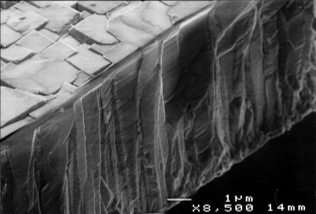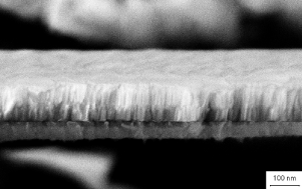Hard coatings
Hard coatings
CVD-diamond layers

SEM picture of a heteroepitactically grown diamond film
Diamond is the hardest material
on earth and its potential in the area of wear protection for mechanical
devices and tools is enormous. It is possible to deposit diamond via a chemical-vapour-deposition
(CVD) process (CH4/H2-mixture) on various substrates.
Usually two different deposition techniques are used: micro-wave plasma
CVD and hot-filament CVD.
On the basis of heteroepitactical diamond films that have been in-situ boron-doped
(Trimethylboran) it was already possible to use the piezoresistivity of
this system to design diamond pressure-sensors and acceleration-sensors.
These devices have their applications in car industry (motors) as well as
the gravitation/navigation-system of aircrafts.
Unfortunatly, these products still have not reached their maturity phase.
Further research is needed to reduce the density of crystal-defects as well
as the production costs. In this context, basic research in the area of
nucleation, growth kinetics at higher deposition-rates as well as in the
area of well-controlled doping with boron or other elements will be essential.
Contact: Xin Jiang
Cubic boron nitride layers

cBN-film, deposited via ECR-MWCVD
Another outstanding hard-coating
material is cubic boron nitride (cBN). CBN is a material with a broad
spectrum of extreme properties. Some of its properties are comparable
with those of diamond, but others - more application relevant properties
- are even superior to those of diamond.
Researcher persue the synthesis of cubic boron nitride films via low-pressure
deposition techniques for more than 20 years. But as all deposited films
showed very high internal stresses, it was only possible to generate films
with thicknesses below 200nm making any commercial application doubtful.
Additionally these films consisted of very small crystallites of bad quality.
Recently, two Japanese scientists, Zhang and Matsumoto, developed a fluorine-chemistry-based
concept that allows the deposition of thick (> 20 µm), well-adherent
films with high crystallinity (similar to the crystallinity observed in
cBN generated by high-pressure-synthesis). This was the first vapour-deposition-based
approach for the synthesis of cBN ever shown. For a couple of years now,
a fruitful relationship exists between those two scientists and our group.
Further investigations about the potential of cBN in technical applications
are planned.
Contact: Xin Jiang
